

Car owners who want a lasting, glossy finish and advanced protection for their vehicles often consider a professional ceramic coating service. This specialist process involves applying a liquid polymer that chemically bonds with a vehicle’s existing factory paint, creating a durable shield. Appointments are more involved than a standard car wash or wax, as precise surface preparation and technical application are key for optimal results. But what exactly should someone expect when they book a ceramic coating service appointment?
The process typically requires customers to leave their vehicles with automotive detailers for several hours, or even overnight. The procedure covers a thorough multi-step cleaning, surface correction, and then multiple layers of ceramic protective coating. Detailing experts use advanced products, tools, and meticulous methods to ensure the result is both visually impressive and functionally protective. The customer experience is more akin to a premium treatment than routine maintenance.
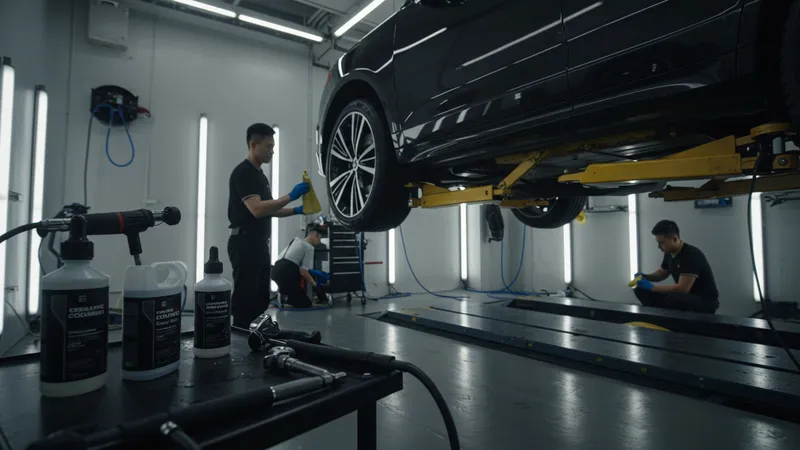
Ceramic coating appointments in the United States are increasingly popular, with more drivers seeking the advantages of advanced paint protection. Unlike regular waxing, which lasts only weeks, ceramic coatings are designed to provide years of hydrophobic and UV-resistant defense. The difference is not just in durability, but also in the maintenance routine required afterward—coated cars need less frequent washing and fewer harsh chemicals.
Before the protective layers are applied, professionals spend a surprising amount of time on surface decontamination and paint correction. This phase may involve clay bar treatments and machine polishing to remove microscopic debris and swirl marks that could otherwise be locked under the coating, reducing its effectiveness. The pre-coating prep is as critical as the actual ceramic layer.
One noteworthy feature is the level of warranty and aftercare offered by top-tier ceramic coating brands in the United States. Packages like Ceramic Pro Gold or CQuartz often include multi-year warranties when installed by certified detailers, along with detailed aftercare instructions. This assurance is appealing to car owners who want long-term peace of mind for their investment.
The cost and time commitment involved are balanced by the reduction in ongoing cosmetic maintenance and the boosted market value of well-protected vehicles. In major US cities where road salt, UV exposure, and pollution threaten paintwork daily, ceramic coatings can be a strategic investment. Customers can generally expect professional detailers to explain every step of the process and offer guidance on care post-service.
Appointments don’t end when the coating is applied: inspection and curing procedures are critical for ensuring the longevity of the finish. Next, discover the inside details about scheduling, typical timeframes, and what sets apart the United States’ most advanced ceramic coating services. The deeper details reveal even more valuable insights ahead…
Booking a ceramic coating service appointment in the United States often requires advance scheduling, especially during peak car care seasons in spring and fall. Many high-end detailers limit the number of vehicles they can service per day, due to the time-sensitive steps and controlled environment required for optimal results. Customers should expect to reserve their spot at least a week in advance and be prepared for flexible drop-off and pick-up times, depending on the facility’s workload and curing protocols.
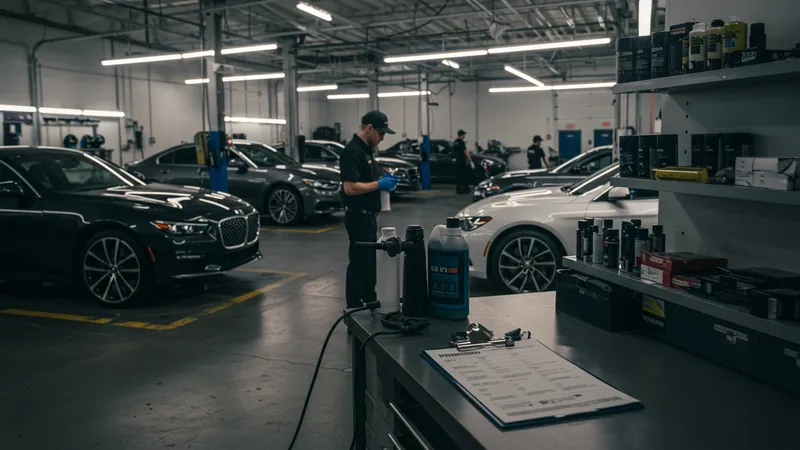
The initial consultation may involve a brief vehicle inspection to assess the paint’s current condition and discuss service options. Experienced detailers will provide an estimate based on the size of the vehicle, previous paint correction needs, and the desired coating package. US car owners will also receive written documentation outlining warranty terms, aftercare requirements, and what to expect during the hand-off and return process.
Many professional shops in the United States, particularly in larger cities, offer shuttle services or loaner vehicles for customers who need alternative transportation while their car is being treated. This added convenience can be a deciding factor for busy professionals or families. Additionally, some locations allow for weekend or after-hours drop-off to accommodate demanding schedules.
Customers are typically reminded to remove personal belongings from their vehicle before appointment day. Any additional accessories, aftermarket vinyl wraps, or non-standard paintwork should be disclosed during scheduling, as these can impact both preparation steps and final results. Next, we’ll examine what happens during the meticulous vehicle inspection and prep phase at top US ceramic coating studios.
The foundation of a durable ceramic coating lies in meticulous preparation, which US detailers approach with precision. The process starts with a multi-stage wash to remove surface grime, brake dust, and chemical contaminants. Technicians then use clay bar treatments to extract embedded particles invisible to the naked eye, ensuring the underlying paint is completely clean and smooth.
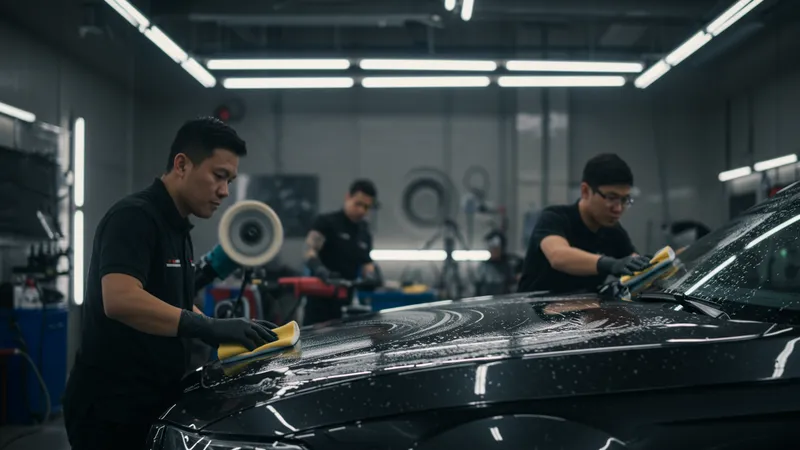
For vehicles with swirl marks, oxidation, or minor scratches, the next step is paint correction. This may include multi-step machine polishing using specialized pads and compounds to restore gloss and clarity. Even new cars often require some level of correction to address transport or dealership handling marks.
Once the surface is flawless, decontaminated, and dry, technicians use isopropyl alcohol or similar solvents to eliminate any residual oils or polishing agents. This critical step ensures the ceramic coating forms a strong chemical bond directly with the paint, maximizing both longevity and effectiveness.
In the United States, variable climates also mean detailers may adjust preparation protocols for humidity, temperature, and regional contaminants. For example, Midwest shops may pay extra attention to salt stains and deposits, while Southwestern locations must account for sun-baked dust and sand. After preparation, the stage is set for the transformative ceramic coating application process.
Applying a high-quality ceramic coating is a precise and controlled process. Top-tier services like those offering CQuartz, Ceramic Pro, or Gtechniq rely on certified technicians trained in layered application techniques. Each coating is carefully applied using special microfiber applicators, ensuring even coverage panel by panel. Some US studios use UV lights or infrared lamps to accelerate the initial curing stage and guarantee a flawless finish.
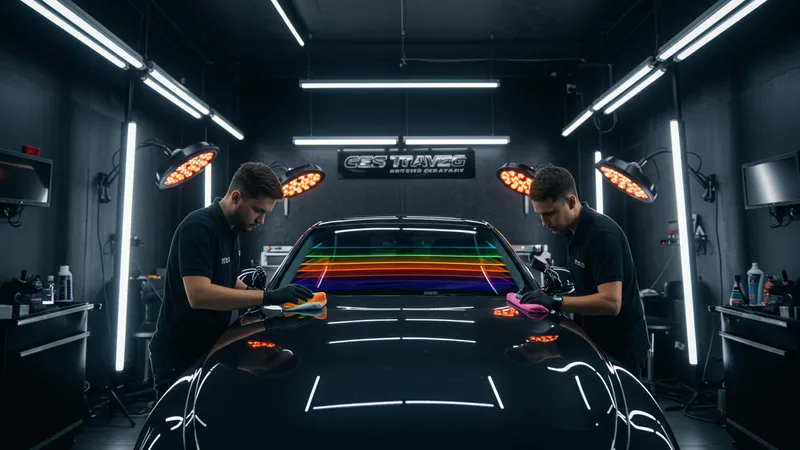
Multiple coats are sometimes layered for enhanced protection, with each layer requiring time to flash, cure, and bond. Only after a thorough inspection will detailers proceed to additional coats, if included in the selected package. This methodical approach minimizes the chance of high spots or streaks, which can mar an otherwise glassy result.
After all coatings are applied, a critical final inspection is performed under various light sources to ensure a streak-free, uniform shield. US studios often recommend keeping the vehicle indoors for up to 24 hours—or longer in colder climates—for optimal curing. During this period, the car should not be washed or exposed to rain or abrasive debris.
This careful attention ensures the protective barrier is fully set and ready to deliver years of defense against US environmental threats such as UV rays, acid rain, pollen, and de-icing agents. Up next, discover the aftercare instructions and long-term maintenance tips that ensure your investment in ceramic protection pays off.
Once a ceramic coating is applied, US car owners receive detailed aftercare instructions to maximize longevity and shine. For the first week, it’s critical to avoid washing the car or exposing it to harsh chemicals. Most studios suggest handwashing with pH-neutral soaps and soft microfiber mitts long-term, as automated or abrasive washes can diminish the hydrophobic surface effect.
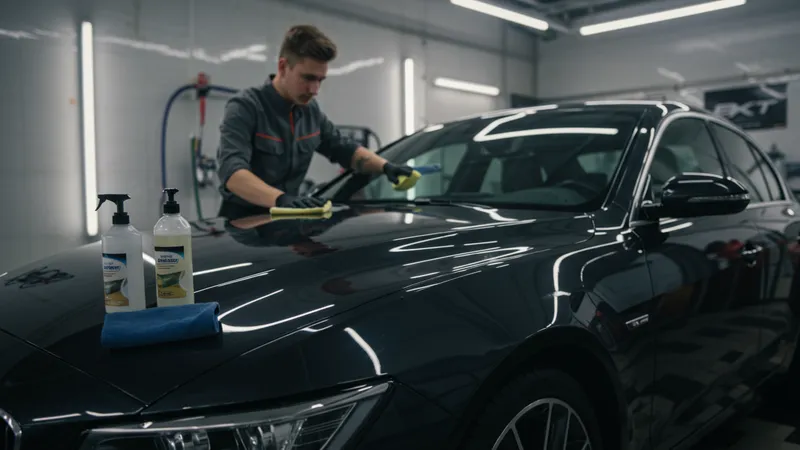
Many ceramic coating packages, such as Gtechniq Crystal Serum Ultra, include annual inspection appointments to assess coating performance and apply booster sprays if needed. This keeps the water-repellent and gloss-boosting properties at peak levels. Warranty coverage may require documented maintenance visits, making compliance an important aspect for US owners who want to maintain validity.
Regional climate considerations play a role in keeping coatings effective. For example, in snowy northern states, extra care is required to gently remove ice and salt without scratching the surface. In sun-intensive locales, regular gentle washing helps maintain the distinctive ‘wet look’ shine unique to ceramic finishes.
Quality ceramic coatings offer a visible payoff: easier washing, reduced fading, and better resistance to bird droppings, tree sap, and road grime. With appropriate maintenance and annual checkups at certified US detailing centers, the benefits can last for several years—helping to preserve both the appearance and the value of your vehicle.